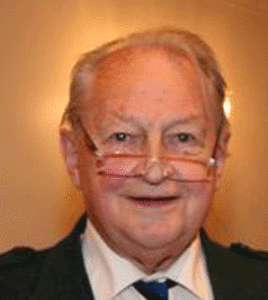THE HIGHLAND SOCIETY OF LONDON
By Angus Nicol
 The Highland Society of London grew out of the failure of the ‘Forty-five, and especially out of its aftermath. Many more people, nearly all Highland men and women, died after Culloden than had lost their lives in the Prince’s cause before 16th April 1745, and a fearful revenge was being exacted against the Highlands led by Cumberland.
The Highland Society of London grew out of the failure of the ‘Forty-five, and especially out of its aftermath. Many more people, nearly all Highland men and women, died after Culloden than had lost their lives in the Prince’s cause before 16th April 1745, and a fearful revenge was being exacted against the Highlands led by Cumberland.
One of the less destructive, but none the less life-changing, measures was the passing of the Disarming Act of 1746, which, amongst other provisions forbade the wearing of the tartan, the carrying of arms by Highlanders, and the playing of the Great Highland Bagpipe. Another was the seizing by the Westminster Government of extensive lands in the Highlands held by Clans or chiefs who had come out for Prince Charles Edward. Many crofts and villages were cleared and the houses burnt both before and after the Clearances during which some Chiefs turned their clansmen and women off the land in order to make room for sheep, so as to make the lands pay.
Little, if anything, could be done against the more violent reprisals. But in Parliament steps were beginning to be taken to repeal the Disarming Act and to restore the confiscated lands. On 28th May 1778 a number of Highland gentlemen met at the Spring Garden Coffee House in London, with the purpose of forming a society that “might prove beneficial to that part of the Kingdom”. Its first President was Lt. General Simon Lovat, the 12th Lord Lovat, descendant of that Lord Lovat who was beheaded for his part in the ‘Forty-five, at Carlisle in 1751 The newly formed Highland Society began intense lobbying in Parliament, which, in some three years, bore fruit.
Eezidrones
FALKIRK, 1782
One of the ways in which the Society sought to influence the Government was the holding of a piping competition. They chose Falkirk, principally because it lies roughly on that imaginary but acknowledged demarcation known as the Highland Line. The playing of the bagpipe was forbidden in the Highlands, and it would have been very difficult to prove, at that time, that piping in Falkirk was in the Highlands or not. This, the first ever piping competition anything like those we know today, took place on 12th October 1782. The date was important, too. At that time each year there took place the Falkirk Tryst. This lasted for about a fortnight, and was essentially a very large fair at which cattle and other farm animals and equipment were bought and sold. To this event came people to buy or sell from all over Scotland, from the Orkneys, from Ulster and even from the north of England. Consequently Falkirk was crowded, and the evenings saw, as one might well imagine, a good deal of conviviality. It was in the middle of this that the first Falkirk piping completion took place. It was not forgotten, either, that at Falkirk there took place, in 1745, the first defeat of the Government troops by a Highland army. Not only was there the political motive for the occasion, but it was greatly feared (as perhaps the Government hoped) that the playing of the bagpipe and its music, especially ceòl mór, might die out. The Society therefore invited thirteen pipers, all those of whom they could hear who were said to be able players, to compete during the Falkirk Tryst.
 There is quite a good account of the Society’s competitions, annual at first and then triennial, to be found in Angus Mackay’s book (left). It appears also in the programme printed for the bicentenary competition, also at Falkirk, in 1982 (more on this and how it spawned today’s MacGregor Memorial competition to follow). For the early years the facts were probably gathered by Angus MacKay from his father, and latterly by Angus himself. After Duncan Ban MacIntyre had recited a poem in praise of the Gaelic language and of the Highland Bagpipe, composed for the occasion (also reproduced in the Bicentenary programme), the pipers played in a courtyard, and the judges sat in an upper room next to the courtyard, where they could hear but not see the competitors. The competitors had to play four tunes from a number which they had submitted. The winner in that first year was Patrick MacGregor. He was the son of John MacGregor who had been Prince Charles Edward’s piper during the ‘Forty-five. The first prize was a prize pipe, made for the Society by Hugh Robertson, of Edinburgh. John MacGregor himself won third prize, at the age of 73, and second prize in the following year, his younger son, John, taking third prize. Angus MacKay was a prize-winner at the age of 14 in 1826, and won first prize in 1835.
There is quite a good account of the Society’s competitions, annual at first and then triennial, to be found in Angus Mackay’s book (left). It appears also in the programme printed for the bicentenary competition, also at Falkirk, in 1982 (more on this and how it spawned today’s MacGregor Memorial competition to follow). For the early years the facts were probably gathered by Angus MacKay from his father, and latterly by Angus himself. After Duncan Ban MacIntyre had recited a poem in praise of the Gaelic language and of the Highland Bagpipe, composed for the occasion (also reproduced in the Bicentenary programme), the pipers played in a courtyard, and the judges sat in an upper room next to the courtyard, where they could hear but not see the competitors. The competitors had to play four tunes from a number which they had submitted. The winner in that first year was Patrick MacGregor. He was the son of John MacGregor who had been Prince Charles Edward’s piper during the ‘Forty-five. The first prize was a prize pipe, made for the Society by Hugh Robertson, of Edinburgh. John MacGregor himself won third prize, at the age of 73, and second prize in the following year, his younger son, John, taking third prize. Angus MacKay was a prize-winner at the age of 14 in 1826, and won first prize in 1835.
These MacGregors were from Druim Charraig, near Fortingall. They were known as Clann nan Sgeulaiche (the family of the storytellers). They ran a school of piping at Druim Charraig, and it is said that they used to send their best pupils to Boreraig to be finished by the MacCrimmons. They were clearly a family of talented pipers, since the sons and grandsons of John MacGregor dominated the prize lists for some decades after 1782.
Classic Piob 1
The competition was a marked success, and continued annually until1784 at Falkirk, after which it was removed to more roomy premises in Edinburgh. It remained an annual event until 1826, after which it became triennial. By that time the Northern Meeting had begun holding annual piping competitions. But the political motive was also wholly effective. Later in 1782 the Disarming Act of 1746 was repealed insofar as was necessary to allow Highlanders freely to wear the tartan, carry arms, and play the bagpipe. And in another year the confiscated lands were restored.
These events were recorded in poetry by Duncan Ban MacIntyre, who was commissioned to compose a poem suitable to celebrate the holding of the Falkirk Tryst Competition. He also composed another, in praise of the Gaelic language and the Great Highland Bagpipe, for each of the next four Falkirk competitions. His very famous poem, “Fhuair mi naidheachd an diugh” (I got news today) which is still sung today, celebrates the restoration of the confiscated lands, attributing the success in this field to the Marquess Graham, son of the Duke of Montrose, then President of the Society, and the Society itself.
THE NINETEENTH CENTURY AND AFTER
In the 19th century, the Society became incorporated by statute in the Highland Society of London Incorporation Act 1816 (56 Geo. III cap. 20). That Act contains a very brief history of the Society over the previous 48 years, and otherwise sets out the rules by which the \Society is still governed. From time to time, the Rules of the Society, which conform to those set out in the Act, are modified, within the ambit of the Act, to bring them up to date. But the objects, though slightly differently expressed since the last amendment to the Rules in 2014, are still those for the preservation of Highland culture and music, and of the Gaelic language, and of the support and improvement of the lot of those inhabitants of the Highlands. In 1965, the Society became registered as a charity.
The Society also supported the recording of ceòl mór in staff notation. The first such book was produced by Donald MacDonald, with the financial support of the Society in 1820. This was followed in 1838 by Angus MacKay’s book, commissioned by and dedicated to the Society, in which the method of recording ceòl mór in staff notation was taken somewhat further than had Donald MacDonald.
When the Northern Meeting began to hold piping competitions, in 1841, the Society at first presented annually a prize pipe for the first prize winner. Later the Society awarded a gold medal for a competition for pipers who had already won the prize pipe and were therefore debarred from competing again. The Argyllshire Gathering was founded, in 1871, and from 1873 the Society has presented a Gold Medal each year.

Since 1879 the Society has also presented a Gold Medal to be awarded at the Northern Meeting. These two gold medals are the highest awards for ceòl mór, or piobaireachd, in any competitions in the world. There are, however, also prizes awarded at Oban and Inverness, and also at the Scottish Piping Society of London’s annual competitions, for which only those who have already won one of the two Gold Medals may enter. These events are the Senior Piobaireachd Competition at Oban and the Clasp to the Gold Medal at Inverness, also the Bratach Gorm at the London competitions. Today an annual donation is given to the Argyllshire Gathering, Northern Meeting, and Scottish Piping Society of London. Currently this stands at £1,500 to each.
A further result of the piping competitions, and the consequent resuscitation of piping, was the later recruiting of pipers to a number of army regiments. Sir John Sinclair of Ulbster gave it as his opinion that “…had it not been for the exertions of the Society, the Army would not have been supplied with Highland Pipers, so rapidly was that species of music sinking into oblivion.”
OTHER CHARITABLE ACTIVITIES
The Society has not confined its activities and donations to piping. Amongst other projects, the Society commissioned the Rev. Dr. MacLeod’s Gaelic-English and English-Gaelic dictionary, published in 1832. It is undoubtedly one of the best such dictionaries ever produced, a most scholarly work, and one of the sources tapped by Edward Dwelly when compiling his Gaelic-English Dictionary some 70 years later, also supported by the Society. The Society raised the Scottish Horse, of 1,250 men, during the war in South Africa. That regiment was expanded after its return from South Africa, and fought in both World Wars. In 1908, on the death of the Baroness von Wilczek, who had been born a Mackenzie, her will provided a capital sum for the benefit of widow and orphans of soldiers of Highland Regiments, the charitable fund to be administered by the Society. This charity has been making payments to such widows down to the present day, and has been subsumed into the Society itself, though still administered separately.
The Society continues to support Highland cultural activities, other than piping. Prizes are awarded annually at the Royal National Mod for the first prize-winners of the two competitions, one for girls and one for boys, aged between 16 and 18 years, in singing a solo Gaelic song. A prize is awarded annually for the best Gaelic dissertation by a student of the University of the Highlands and Islands. Another is awarded through the Royal Scottish Academy for a work of art. Awards were made to the London Gaelic Choir to assist in the production of a CD of Gaelic songs. Yet another is awarded annually for the best Highland dancer at the Queen Victoria School, Dunblane.
• To follow: The MacGregor Memorial competition and its origins.




















Sorry, but it is pretty clear Reid’s execution had nothing to do with his being a piper.
There is an excellent critical (as in “historical critical”) history of the influence of the Highland Societies on piping by Ian MacInnes, submitted to his Masters committee in 1988. It is an excellent supplement to this article.
Assuming the editor of Piping Press doesn’t mind that I include a link, you may enjoy reading it here:
http://www.altpibroch.com/learning/research/the-highland-bagpipe-the-impact-of-the-highland-societies-of-london-and-scotland-1781-1844/
In direct answer to Patrick’s question, pg. 14 (second link) may be of interest:
”The bagpipe in fact was not mentioned in the Disarming Act which concentrated on weaponry and highland garb, although it is true that a young unfortunate in the Ogilvie Regiment was hanged in York in November 1746, for acting as a piper in the Jacobite cause…”
David
No problem at all with this sort of link. The more the merrier. The point is that the judge’s interpretation of the act meant that poor piper James Reid had his neck stretched, if that is not putting things too gruesomely. The message to pipers everywhere was play this instrument at your peril, nay on pain of death, a tacit ban if ever there was one. RW.
Angus Nicol starts his article saying ” One of the less destructive, but none the less life-changing, measures was the passing of the Disarming Act of 1746, which, amongst other provisions forbade the wearing of the tartan, the carrying of arms by Highlanders, and the playing of the Great Highland Bagpipe”
In his book ” The Highland Pipe and Scottish Society ” 1750-1950 , William Donaldson writes : ” It is frequently claimed that the pipes , too , were proscribed , but there is no mention of bagpipes in the Disarming Acts , nor contemporary evidence that they were forbidden or discouraged ”
Could someone tell us what the situation was like exactly ?
Thank you .
Patrick Molard